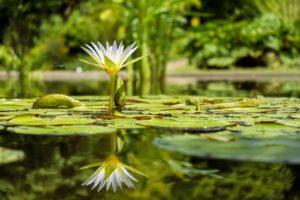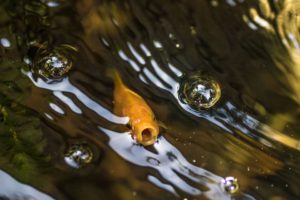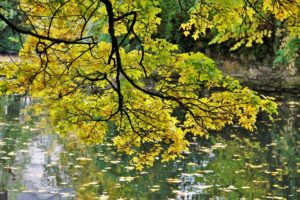Pond Maintenance
SPRING
Spring is when our ponds start to come back to life and we start to see our plants, especially water lilies, rejuvenate from their winter dormancy. This is the best time to introduce new plants, re-pot (if needed) and to give plants a little boost with some aquatic fertilizer tablets. If you are re-potting any plants, we recommend to use an aquatic potting mix or a mild soil without too much nutrient content. Excess nutrient may encourage algae growth.

Algae is a natural part to any pond. With the increase of sunlight you may start having algae issues. There are a number of solutions depending on the issue at hand. There are generally two types of algae people notice in their ponds, string algae or pea-soup green water. A UV light is the fool-proof way of getting rid of this pea-soup green water. A number of liquid and powder treatments are available to help keep the algae under control.
The colder months may have accumulated a build up of sludge within the pond. If this is the case, you can give your pond a bit of a freshen up with a vacuum or even a 25% water change. There are treatments available that can help to eat away at this sludge build-up.
Beneficial bacteria is slower to come out of winter dormancy. You can give it a kick start with a boost of Clarifier Bacteria.
SUMMER
This is the season where most people will have issues with algae. Algae is a natural part of the pond ecosystem, but if it gets out of control it can take over and become unsightly, and eventually cause problems for other aquatic wildlife. There are a number of treatments available depending on the issue your are having with algae. You can control algae by reducing certain factors, such as sunlight and nutrients. CLICK HERE to read our article on algae.
 Oxygen is one of the most essential parts of a pond, especially during these warmer months. The warmer water holds less oxygen and it’s the time of year where your fish really need it. The best way to get the oxygen going, is to have your pump propelling water up, breaking the surface of the water, and allowing air to be mixed in. You can achieve this by either having the pump bubbling water up from the outlet, have a fountain nozzle attached to the pump or have the water moving to a waterfall. If you’re not too keen on this you can either have an aerator or provide more plants for your pond.
Oxygen is one of the most essential parts of a pond, especially during these warmer months. The warmer water holds less oxygen and it’s the time of year where your fish really need it. The best way to get the oxygen going, is to have your pump propelling water up, breaking the surface of the water, and allowing air to be mixed in. You can achieve this by either having the pump bubbling water up from the outlet, have a fountain nozzle attached to the pump or have the water moving to a waterfall. If you’re not too keen on this you can either have an aerator or provide more plants for your pond.
MAKE SURE TO HAVE YOUR PUMP GOING 24/7, AS THE LOWEST POINT OF OXYGEN IN A POND IS TWELVE AT NIGHT TILL SIX IN THE MORNING.
During this month you will be topping up your pond a lot through evaporation and remembering to use water conditioner will stop any chemicals from harming your fish.
Fish will become more active during this time and may require more feeding, but care needs to be taken to not overfeed. PondMAX Premium Koi & Goldfish Food is specially formulated in Australia to promote a healthy immune system. The food will not cloud your pond water and ensures fish grow to their full potential.
AUTUMN
With the cooler weather, it’s a great time to give your pond a good clean-out before winter and cut back any decaying plant leaves. During this time you can give your pond a freshen up, with a partial water change (twenty five percent). A pond treatment, such as BactiMax, can be added to the pond. This product helps to maintain the pond and can be used every two weeks. BactiMax is a good year-round treatment.

With the shedding of tress the leaves can cause a nuisance in our ponds. Leaves in our ponds cause an imbalance in the natural health of the pond when they breakdown and contribute to the excess nutrient which in turn can add to algae growth. Continuing with a regular dosage of bacteria will aid in converting excess nutrient so it is then eliminated from the pond. Putting bird netting over your pond will help to catch any troublesome leaves, otherwise you can manually scoop out any leaves with a fish net.
Again adding to that waste build-up will be any un-eaten food. With the weather getting cooler, you can start to reduce the amount you are giving the fish, as they become less active. They may try that whole, “I’m starving!! Why are you doing this to me?!” act, but trust me they don’t need it. You can even try feeding them lighter foods such as PondMax Premium All Season. This feed is enriched with higher quality ingredients for easier digestion resulting in reduced pond pollution.
WINTER
Water Lilies will go dormant through the winter period. The foliage may become sparse or the lily might die right back. Do not remove the pot or lily from the water. They will come back in Spring when the temperature warms up.
Make sure pond heaters are in working order. Most types of pond fish can handle the colder temperatures without heating. Fish, such as Koi and Goldfish, may lay on the bottom of the bottom and not move around too much. As the fish are not as active, feeding can be reduced and even stopped during this period.
Just like fish, parasites and pathogens, will go into dormancy during Winter, making their immune systems vulnerable coming into Spring. So in saying that, giving your fish an all-round treatment before Spring, will help stop any pathogens from regenerating rapidly and give your fish that extra boost coming back into the warmer weather. Pond Salt is a good all-round treatment that can be used. It can reduce fish stress, add essential electrolytes, improve gill function, improve recovery from injuries or disease and help protect them from nitrite toxicity. But take note; once in the water salt does not go anywhere so you have to be careful not to overdo it. Salt will not be evaporated out, nor will it be filtered out. You can only remove salt by doing a partial water change, which won’t remove all the salt, so again you have to be careful if you are thinking of doing a re-dose.
